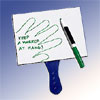9 Ways to increase student engagement
As I culled through this week’s Marshall Memo I was pleased to find a bunch of suggestions to increase student participation. I was even more pleased that “Dry-erase boards” made the list.
I believe it was about 10 years ago that we were sitting in a Trainers Warehouse product meeting, thinking about creative ways we could use whiteboards to enhance a training and learning environment. My dad, then in his mid-60s, expressed his personal frustration regarding the difficulty in reading small-print name badges. That started our brainstorm. In the end, we decided to launch a new product called “whiteboard on a stick,” which could be used for multiple purposes — name badges, walk-around icebreakers, and answer boards. By far, the most popular use of “Whiteboards-on-a-Stick” has been answer boards. Since then, we’ve been flattered to see the idea replicated many “do-it-yourselfers.”
For the other 8 eight ideas, you can read Kim Marshall‘s synopsis below:
In this Kappa Delta Pi Record article, Greg Conderman and Laura Hedin of Northern Illinois University and Chicago-area teacher Val Bresnahan describe some ways that effective teachers increase students’ active involvement and thereby boost learning:
• Unison responses – The teacher asks a question, allows a few moments of think time, uses a verbal or non-verbal cue for students to give a choral response, and then confirms or reinforces the right answer. For example, When I touch each underlined digit in each number on the overhead, say its place value, or I will say the state name, and when I signal, say the capital city. “Unison responses encourage all students to actively practice many skills throughout an instructional period, provide teachers with frequent information about each student’s progress, maintain students’ attention, and thus significantly accelerate student progress,” say the authors.
• Response cards – Students write the answers to all-class questions on index cards, and the teacher scans them and validates right answers. Different answers might be signaled by different color cards. For example, in a music class, students might hold up the card for the musical genre they just heard. Incorrect answers cue the teacher to reteach or clarify student misconceptions.
• Dry-erase boards – Students write answers to an all-class question on their individual boards (for example, Write as many words as you can that rhyme with fall) and then, on a signal, hold them up, allowing the teacher to see how students did and follow up if necessary.
• Thumbs Up, Thumbs Down – Students can indicate their response to a question with these hand signals – for example, Can a country with a monarchy government impeach its ruler? or Does a mammal’s body temperature change?
• Numbered heads together – The teacher poses a question and small cooperative groups discuss what the right answer is. Students within each group have a number, and the teacher then calls on a particular number at random for a response. All students with that number stand to share their group’s answer (or display them on dry-erase boards). For example, groups might evaluate a piece of writing using a rubric.
• Jigsaw – A unit of study is cut into component parts, each member of 5-or-6-student cooperative groups is given a piece, has time to study it, gathers in “expert” groups to think it through, and then returns to his or her cooperative group where students teach their pieces and the group works on understanding the unit as a whole. For example, students might use jigsaw to study several aspects of a country or region – history, natural resources, tourist attractions, famous citizens, and industries.
• Reciprocal teaching – The teacher reads a passage and thinks aloud to model four comprehension strategies: questioning, summarizing, clarifying, and predicting. Working in groups, students gradually take over responsibility for these four skills, with the teacher circulating to monitor their work. For example, a science teacher might have students read a section of a textbook on renewable resources to identify main ideas and predict impact.
• Think-pair-share – The teacher gives students an open-ended question to consider, gives think time (during which students might jot ideas), then has students pair up and discuss their ideas with a partner and respond to a challenge or task. Pairs then share their ideas with the whole class. For example, an English teacher might ask pairs to identify one character in a novel or play and think of distinguishing characteristics and traits.
• Peer teaching – Students sit in pairs and each partner takes a turn teaching an instructional task that the teacher introduced earlier. This requires careful pairing of students and prior training in tutoring skills, but is a valuable activity for students at all levels.
“Promoting Active Involvement in Today’s Classrooms” by Greg Conderman, Val Bresnahan, and Laura Hedin in Kappa Delta Pi Record, Summer 2011 (Vol. 47, #4, p. 174-180), https://kdpconnect.kdp.org/jit/download.aspx?ProductNumber=RSM11_Conderman.
Kim Marshall offers a terrific reading service! The subscription is affordable, well-written, and keeps you up-to-date on the education industry.



1 thought on “9 Ways to increase student engagement”